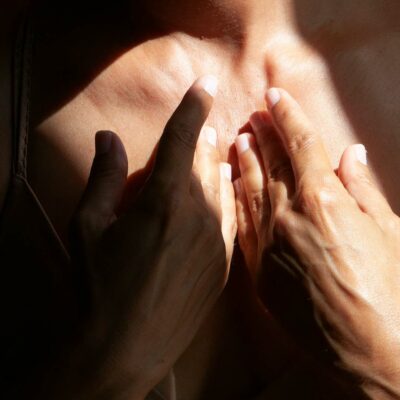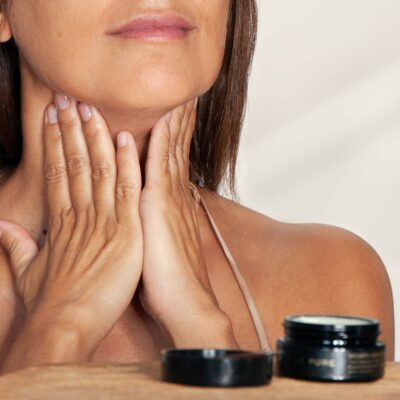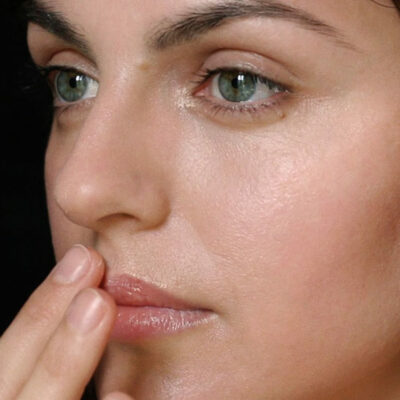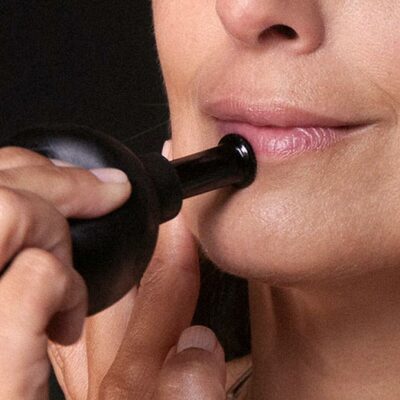Treatment for Seborrheic Dermatitis
Seborrheic dermatitis is a very common inflammatory skin disorder that causes desquamation (peeling skin) and redness on certain skin areas. It is a chronic or relapsing condition and the treatment for seborrheic dermatitis needs to address the external as well as internal causes.
Seborrheic skin has an imbalance of the essential fatty acids (Omega 3, 6, 7 and 9) in the sebaceous glands. The altered skin sebum is very acid and causes inflammation when it reaches the skin surface, resulting in alternating cycles of skin redness and subsequent desquamation. These cycles frequently create a sensation of skin tightness, which is often mistaken with skin dryness.
Seborrheic skin can easily be distinguished from dry skin by observing the pores. While dry skin has fine pores, skin with seborrheic dermatitis is characterized by enlarged pores. The areas where the redness and desquamation appear, clearly indicate the seborrheic tendencies of the skin. Seborrheic dermatitis generally appears in cycles and is influenced by a variety of factors that stimulate the skin sebum, leading to an aggravation of this skin disorder.
Products for Seborrheic Dermatitis
Seborrheic Dermatitis Skincare Routine
The ideal Seborrheic Dermatitis Skincare Routine balances the skin sebum and regenerates the areas with redness and desquamation. It is essential to provide the skin with only a small quantity of lipids (beneficial fats) that have a balancing effect on the skin sebum.
Even if the skin feels dry and pulling, the correct treatment is not the application of products rich in oil, but the combination of products that balance the skin sebum and a very small quantity of lipids.
Day Routine Seborrheic Dermatitis
Cleanse the skin with Alpha Tonic. Apply 1 dose of Way to Radiance and massage it into the skin.
Night Routine Seborrheic Dermatitis
Apply Alpha Tonic on a cotton pad moistened with filtered water and gently cleanse following the Antiaging Face Cleansing Ritual. Spray Nectar Immortel onto the face and gently massage 1 dose of Midnight Rejuvenation into the damp skin.
Weekly Routine Seborrheic Dermatitis
Once per week after cleansing, apply the gentle exfoliation and natural retinol treatment True Revelation.
Three times per week after your night routine, apply a thin layer of Instant Liberation like a cream and let it act overnight.
As a complementary treatment we recommend the application of one ampoule of zinc and copper from the brand Labcatal. Apply the content of the ampoule once per week at night on the entire face.
What to expect when treating Seborrheic Dermatitis
The causes of seborrheic dermatitis are mostly internal, but with the right organic skincare products you can also treat seborrheic dermatitis naturally from the outside.
It is important to know what to expect when we start treating seborrheic dermatitis. When it comes to the skin, cosmetics marketing has educated us to expect instant results. But the skin does not work that way, especially when there are also many internal factors that can cause or aggravate seborrheic skin.
When starting the seborrheic dermatitis treatment with the LE PURE products, you need to keep the following factors in mind.
1. Products that cover the underlying skin problems with artificial layers
Conventional skincare, including certified organic products, contain synthetic or chemically modified fats that create a layer on the skin surface. This artificial layer mimics hydration and nutrition, but in reality it neither nourishes the deeper layers of skin nor does it improve seborrheic skin. In fact this artificial layer covers the true condition of your skin and can interfere with the skin’s natural healing process.
Once you stop applying products that create this layer, you can feel the real state of your skin. It may feel dry, tight, itchy and burning, and look scaly, uneven, wrinkled and red. Seborrheic skin often feels very uncomfortable, especially if it has been covered with artificial layers for many years. Peeling skin (desquamation) is also part of the natural repair process.
2. LE PURE formulations bring the problem to the surface
The LE PURE products are free from synthetic and chemically modified fats, therefore they don’t deposit a covering layer on the skin surface. All nutrients of the LE PURE formulations are recognized by the skin and instantly absorbed into its deeper layers.
On the outside, you can now feel the real state of the skin, which, as already explained, may feel uncomfortable until the skin has completed one or more skin renewal cycles.
Some people may think that this uncomfortable skin sensation is caused by the LE PURE products or that they don’t nourish the skin sufficiently. But quite the contrary is true – the LE PURE formulations bring the skin problem to the surface and activate the skin’s natural elimination and healing process.
3. Seborrheic skin takes weeks or months to improve
When starting with the LE PURE treatment for seborrheic skin, you need to be both patient and consistent. The skin renews itself in cycles, during which dead or damaged skin cells are removed and replaced with new, healthy cells.
This cycle takes about 4 weeks, which is when the new skin emerges and you can see the first results of the seborrheic skin treatment.
The progress of seborrheic dermatitis depends on the severity of the condition and if the underlying internal causes are being treated at the same time or not.
The skin mirrors what is going on inside of us. If there are important internal imbalances or emotional stress, the skincare treatment for seborrheic dermatitis can only achieve certain results.
In most cases, it takes many weeks or even months until the uncomfortable skin sensations of dryness and tightness improve and eventually disappear.
4. Mixing brands can interfere with the treatment and cause skin alterations
Applying products from different brands can delay the desired skin improvements and give the skin mixed messages. You could compare this to eating a fast food meal and organic fruits and vegetables at the same time.
The medicinal plants of the LE PURE products stimulate the skin to purify itself from any substances it cannot recognize such as synthetic detergents, preservatives and synthetic or chemically modified fats.
If you apply a synthetic or chemically modified substance that the skin cannot recognize it either stays on the skin surface or is stored within the skin. If you apply a LE PURE product right after, the skin may use the stimulation from the medicinal plants to purify and expulse the artificial substances applied just prior.
This purification process can cause impurities, redness or peeling skin. Even if the products from both brands don’t produce a reaction when applied on different days, their combination on the skin can create these types of reactions.
5. Follow the seborrheic skin treatment indications precisely
It is crucial that the treatment is followed as precisely as possible to bring the desired results as fast as possible. Even if the skin is tight and pulling, resist the temptation to apply too much oils and butters. The skin fat can only be rebalanced, if we reduce the amount of lipids (beneficial fats) applied to the skin.
Follow the exact amounts of product as indicated in the treatment. Applying more quantity will not improve the feeling of dryness and tightness.
6. Avoid makeup, foundation and sunscreen with synthetic or chemically modified fats
During the treatment of seborrheic skin it is crucial to allow the skin to breathe and to avoid synthetic and chemically modified fats. These substances are found in almost all makeups, foundations and sunscreen products.
If possible, refrain from using these ingredients or use the LE PURE foundation Perfecting Illumination and the sunscreen balm Zen Solaire.
7. Do not rub seborrheic skin
Every single client that we meet says they don’t rub their skin. But when they show us their cleansing technique it does involve what we consider as “rubbing the skin”. This daily friction is incredibly damaging and aggravates seborrheic skin by stimulating the sebaceous glands to produce even more unbalanced skin fat.
Refer to the Antiaging Face Cleansing Ritual and practice the manual technique of profoundly cleansing your skin without rubbing. Remember that you need to sit down to exercise the movements correctly.
Symptoms of Seborrheic Dermatitis
The symptoms of seborrheic dermatitis include areas with redness and desquamation. Seborrheic dermatitis usually affects the oily parts of the body such as the face, alar wings of the nose, eyebrows, ears, eyelids, chest and décolleté.
Seborrheic skin with desquamation on the scalp is often mistaken for dandruff, which is a different type of skin alteration.
What causes Seborrheic Dermatitis?
The question “what causes seborrheic dermatitis ?” does not have a simple answer. There are multiple internal and external factors that contribute to the development of seborrheic skin. By reviewing and addressing the list of possible causes of seborrheic dermatitis, the skin will start to improve, although it may take multiple weeks or even months until the condition disappears.
1. Nutrition and Seborrheic Dermatitis
Nutrition and seborrheic dermatitis are closely related, as the fats we consume greatly influence the quality of the skin’s sebum. An excess of saturated fats, hydrogenated fats, and foods that are fried or highly processed can gradually alter the balanced composition of sebum. Consuming poor-quality fats can lead to an imbalance between LDL and HDL cholesterol, impacting not just the arteries and heart, but also the composition of the skin sebum. Moreover, such nutrition can result in a deficiency of Omega 3, which again favours the appearance of seborrheic dermatitis.
It’s crucial not to cook Omega 3-rich fish and meat at excessively high temperatures, as this can produce potentially harmful oxidation compounds that, when ingested regularly, may strain the liver. We advise against consuming highly processed, rapidly absorbed sugars (like sucrose, glucose, and fructose) because frequent intake can lead to conditions like diabetes, metabolic issues, and fat accumulation in tissues.
Many processed foods, such as bakery goods, contain sugars as well as hydrogenated and/or trans fats that can negatively affect the pancreas, intestines, and skin. Consuming too much gluten can also upset metabolic balance.
While consuming small amounts of fruit is beneficial, drinking fruit juices is not, especially in the morning. Without chewing the fruit, we miss out on its fibers and cellulose that help slow sugar absorption.
2. Medication and Seborrheic Skin
If, within three months before the onset of seborrheic dermatitis, you have taken a new medication or nutritional supplement, it’s advised to review all its components since one of them might be causing or exacerbating the seborrheic condition.
Likewise, if you have altered your diet (added juices, smoothies or any other foods) or the way you prepare food (cooking Omega 3 at elevated temperatures), these changes can also have a negative effect on the composition of your sebum (skin fat).
3. Skin Type and Seborrheic Dermatitis
Thick, oily, and combination skin types have a higher predisposition to seborrheic dermatitis. This condition can worsen if the skin undergoes changes in climate or nutrition.
Skin types with thin skin can also develop seborrheic dermatitis. In such cases, it is recommended to treat areas with dry skin according to the respective protocol for skin dryness, and apply the treatment for seborrheic dermatitis on the areas with red, flaking skin.
4. Climate and Seborrheic Dermatitis
Skin problems related to seborrheic dermatitis tend to occur more often in colder climates and during the winter months when sunlight exposure is reduced. The change of seasons often triggers the appearance of seborrheic skin in individuals that are prone to the condition.
5. Vitamin D and Seborrheic Dermatitis
The reduced sun exposure during fall and winter heightens the risk of vitamin D deficiency, which can exacerbate or reactivate seborrheic dermatitis. We suggest monitoring your vitamin D levels through regular blood tests and seeking advice from an integrative medicine doctor regarding vitamin D supplementation.
6. Deficiencies and Seborrheic Dermatitis
Apart from vitamin D deficiency, seborrheic dermatitis can also be related to nutritional deficiencies such as zinc and the B vitamins. A lack of these substances can make the skin more susceptible to develop dermatological conditions such as seborrheic skin.
It’s crucial not to self-prescribe nutritional supplements. While a supplement may benefit one individual, it could be harmful to another. Recommendations for supplementation should come from an integrative medicine doctor after a blood test.
7. Seborrheic Dermatitis and Hereditary Factors
Every person has a hereditary legacy that influences our deficiencies and hormonal system. Hormonal imbalances directly relate back to all that we have experienced and consumed in our past life. From our time in our mother’s womb to early childhood and adolescence, we accumulate both nutritional and emotional deficiencies.
Although we cannot change the past, we need to understand our developmental and health history to make the best decisions for the future. It’s important to realize that these deficiencies don’t only affect the skin but also have a negative impact on the entire body.
It is crucial for people with seborrheic skin to manage their health properly to achieve balanced and healthy skin. Since these imbalances have developed over a long period of time, it’s vital to understand that they won’t vanish overnight or within a week. With a lot of patience and perseverance, the skin can be treated from the inside as well as the outside to realize substantial and enduring improvements.
8. Hormones and Seborrheic Dermatitis
Hormones and seborrheic dermatitis are often closely related. An unbalanced hormonal system can have a negative influence on the sebaceous glands and contribute to the appearance of seborrheic dermatitis.
9. Liver and Seborrheic Dermatitis
Seborrheic dermatitis is often linked to issues with the liver and/or gallbladder. If either or both of these organs have to work excessively in purifying the body, side effects can manifest as seborrheic skin and hyperpigmentation.
Unbalanced nutrition can strain the liver over time. Consuming sugar (in all its forms), juices, and unhealthy fats can have a negative impact on the liver. Food preparation is also pivotal in avoiding burdening the liver. Cooking Omega 3-rich foods (like fish and meat) at high temperatures in a pan (with or without oil) transforms the Omega 3 essential fatty acids into toxins that burden the liver.
For an overburdened liver, a gentle and gradual detox is essential. Initiating the liver’s cleansing can result in the appearance of pimples. We don’t recommend stimulating a strong liver purification, since the liver’s tissue regenerates slowly. A mild yet extended purification over several months is recommended.
A medical professional should guide you through the process of liver purification and suggest dietary modifications.
10. Immune system and seborrheic skin
An irregular immune system response can also be a primary cause of seborrheic skin. A deficiency in vitamins can compromise the immune system, making the body more susceptible to the onset of the seborrheic condition.
11. Emotions and Seborrheic Dermatitis
Emotions can impact the onset and exacerbation of seborrheic dermatitis symptoms. Emotional stress can affect the hormonal system and the nervous system, subsequently leading to skin-related symptoms.
12. Skin Cleansing and Seborrheic Dermatitis
Seborrheic dermatitis can be caused or aggravated by the skin cleansing products you use or by your application techniques. Almost all cleansers contain soap substances, syndets (synthetic detergents) and/or chemically modified ingredients. These components can irritate the skin, weaken the skin barrier, and imbalance the skin’s microbiome.
Opt instead for cleansers that are formulated skin compatible ingredients such as natural clays, plant extracts, essential oils, and cold-pressed plant oils.
The way you touch your skin, especially in cases of seborrheic dermatitis, is also of utmost importance. Vigorous rubbing during your cleansing routine can stimulate the sebaceous glands, leading to increased sebum production and causing more pronounced redness on the skin.
Please refer to our Antiaging Face Cleansing Ritual to learn the right way to cleanse and prevent exacerbating seborrheic skin.
13. Occlusive Skincare and Seborrheic Skin
Conventional skincare uses synthetic or petroleum based fats. Natural and organic skincare use vegetable oils whose molecular structure has been chemically altered. The result in both cases are fats that the skin cannot absorb. They remain as a layer on the skin surface and are interfering with the natural skin functions of breathing and elimination of toxins.
The tricky thing about this layer is that it creates the sensation of well hydrated and nourished skin, while covering underlying skin problems such as dryness and seborrheic skin. Over time these artificial fats can cause or exacerbate enlarged pores, blackheads, pimples, unbalanced skin fat, rough and dry skin.
The best skin results are achieved when working in alignment with the skin’s natural functions and cycles. LE PURE only uses ingredients that have been minimally modified with physical-mechanical processes that don’t alter the molecular structure of the plants.
The skin recognizes these ingredients as natural and absorbs them instantly into the deeper layers, where they potentiate the skin’s own regeneration processes.
14. Hair Dyes and Seborrheic Dermatitis on the Scalp
Synthetic ingredients of hair dyes can cause or aggravate seborrheic dermatitis on the skin of the hairline and the scalp. We recommend purifying the skin on the hairline with a cotton pad and Nectar Immortel. The plant nutrients of this formulation act as chelating agents and can remove profoundly stored toxins from the skin.
Spray Alpha Hair on the scalp and hair roots after a hair treatment involving hair dyes or other hair treatments.
If you are a hairdresser, keep in mind that you are frequently exposed to these substances and should take precautions as your skin and lungs are affected by them.
15. Alcohol and Seborrheic Dermatitis
Alcohol can cause or exacerbate skin with seborrheic dermatitis. Alcohol consumption has longterm negative effects on the liver and other organs, leading to systemic health problems and seborrheic skin. Even small amounts of alcohol if consumed daily can have damaging effects on your health and skin.
16. Smoking and Seborrheic Dermatits
Smoking strongly affects seborrheic dermatitis and even if you stopped smoking 1-2 years ago, the skin is still suffering from the consequences and may peel like a snake.
The skin is intrinsically connected to the intestine and the lungs, which is why we can often observe skin symptoms if there is a problem with one of these two organs.
The more years you have smoked, the more changes your skin will experience. Right after stopping, you will observe the biggest changes, since the skin acts as the third kidney and starts eliminating the tobacco toxins.
17. Malessezia Yeast and Seborrheic Skin
A fungus called malassezia or pityrosporum can be found in the sebum secretion (skin fat) and it can also appear in case of seborrheic skin. Unbalanced skin fat and microbiome can lead to overgrowth, which can aggravate seborrheic dermatitis.
18. Allergies and Seborrheic Dermatitis
Many people suffer from allergies caused by the air they breathe. These allergies can cause or aggravate seborrheic dermatitis. If the problems with seborrheic skin appear for the first time in spring or summer, an allergic reaction can be a possible aggravating factor. During these allergy-related seasons, some people may also suffer from dermatitis on the eyelids.
19. Diseases and Seborrheic Dermatitis
Certain diseases and medical conditions can contribute to the development of seborrheic dermatitis. Among those are HIV, Parkinson’s disease and epilepsy. Alcoholism, depression and eating disorders can also be aggravating causes of seborrheic dermatitis.
Skin disorders such as acne and rosacea can also lead to the development of seborrheic skin.
























